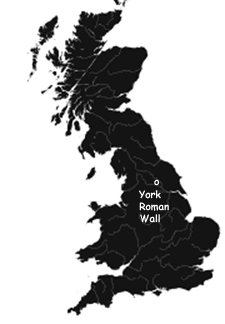 The English city of York has, since Roman times, been defended with walls of one form or another. In 71 A.D., the Romans built a fort occupying about 50 acres on the banks of the River Ouse, and surrounded it with a rectangle of walls. They called their new settlement Eboracum, a latinized form of an old Celtic word probably meaning "Place of the Yew Trees."
The original fort was replaced in 108 A.D. by a massive stone structure with walls that survived the centuries to be used as part of the defences of Viking and Medieval York. The Roman fortress even influenced the layout of York's streets in later centuries, an influence that survives to this day.
The bottom part of the Multangular Tower, located today in the Museum Gardens, is the most noticeable and intact structure remaining from the Roman walls. (Its upper part is medieval in origin.) It was constructed as part of a series of eight similar defensive towers, built on the orders of the Emperor Septimius Severus, who lived in York from 209 to 211 A.D. It has ten sides and is almost 30 feet tall.
Much of the wall has been changed since it was first constructed in the third century.
About the York Roman Remains The English city of York has, since Roman times, been defended with walls of one form or another. In 71 A.D., the Romans built a fort occupying about 50 acres on the banks of the River Ouse, and surrounded it with a rectangle of walls. They called their new settlement Eboracum, a latinized form of an old Celtic word probably meaning "Place of the Yew Trees."
The original fort was replaced in 108 A.D. by a massive stone structure with walls that survived the centuries to be used as part of the defences of Viking and Medieval York. The Roman fortress even influenced the layout of York's streets in later centuries, an influence that survives to this day.
The bottom part of the Multangular Tower, located today in the Museum Gardens, is the most noticeable and intact structure remaining from the Roman walls. (Its upper part is medieval in origin.) It was constructed as part of a series of eight similar defensive towers, built on the orders of the Emperor Septimius Severus, who lived in York from 209 to 211 A.D. It has ten sides and is almost 30 feet tall.
Much of the wall has been changed since it was first constructed in the third century.
About the York Roman Remains
Wikipedia: York City Walls
Megalthic Portal: York Roman Remains
Visit York: City of York Walls
Journey to the York Roman Wall Remains
The York Roman Wall is located in the city of York in North Yorkshire, England.
Ordnance Survey Map (SE6034051773)
Visitors Information
Visitors information and general tourist information may be found on the Visit York website.
Additional Photos of the York Roman Wall
Monk Bar, a Major Gate of the York Roman Wall
Entrance to the City of York Through Monk Bar, York Roman Wall
Walkway Along the York Roman Wall
Multangular Tower, the Western Corner of the York Roman Wall
Plaque Along Walkway, York Roman Wall
A View of the Outerwalls, York Roman Wall
Steps in Monk Bar Leading Down to Street Level, York Roman Wall
|


 The English city of York has, since Roman times, been defended with walls of one form or another. In 71 A.D., the Romans built a fort occupying about 50 acres on the banks of the River Ouse, and surrounded it with a rectangle of walls. They called their new settlement Eboracum, a latinized form of an old Celtic word probably meaning "Place of the Yew Trees."
The original fort was replaced in 108 A.D. by a massive stone structure with walls that survived the centuries to be used as part of the defences of Viking and Medieval York. The Roman fortress even influenced the layout of York's streets in later centuries, an influence that survives to this day.
The bottom part of the Multangular Tower, located today in the Museum Gardens, is the most noticeable and intact structure remaining from the Roman walls. (Its upper part is medieval in origin.) It was constructed as part of a series of eight similar defensive towers, built on the orders of the Emperor Septimius Severus, who lived in York from 209 to 211 A.D. It has ten sides and is almost 30 feet tall.
Much of the wall has been changed since it was first constructed in the third century.
About the York Roman Remains
The English city of York has, since Roman times, been defended with walls of one form or another. In 71 A.D., the Romans built a fort occupying about 50 acres on the banks of the River Ouse, and surrounded it with a rectangle of walls. They called their new settlement Eboracum, a latinized form of an old Celtic word probably meaning "Place of the Yew Trees."
The original fort was replaced in 108 A.D. by a massive stone structure with walls that survived the centuries to be used as part of the defences of Viking and Medieval York. The Roman fortress even influenced the layout of York's streets in later centuries, an influence that survives to this day.
The bottom part of the Multangular Tower, located today in the Museum Gardens, is the most noticeable and intact structure remaining from the Roman walls. (Its upper part is medieval in origin.) It was constructed as part of a series of eight similar defensive towers, built on the orders of the Emperor Septimius Severus, who lived in York from 209 to 211 A.D. It has ten sides and is almost 30 feet tall.
Much of the wall has been changed since it was first constructed in the third century.
About the York Roman Remains